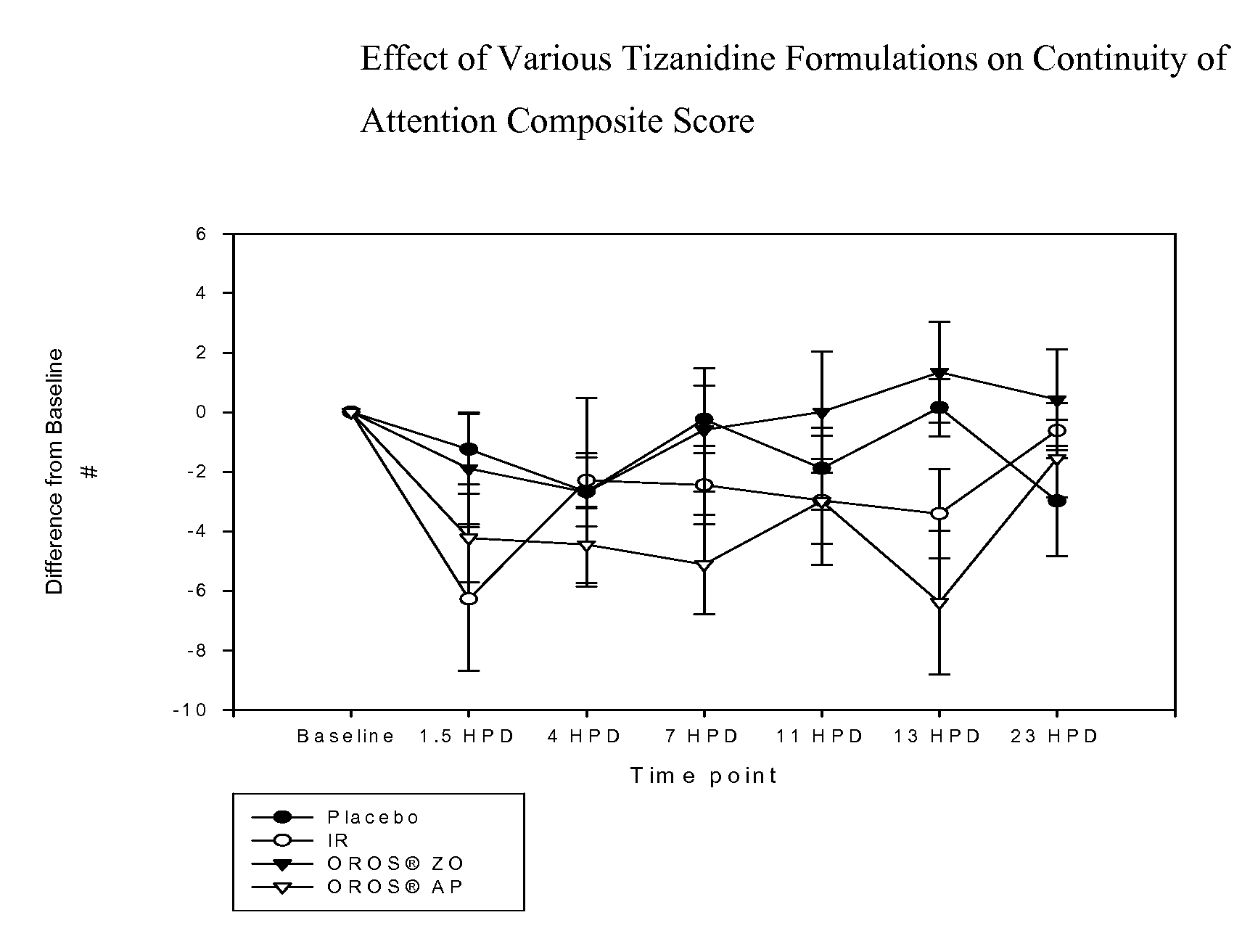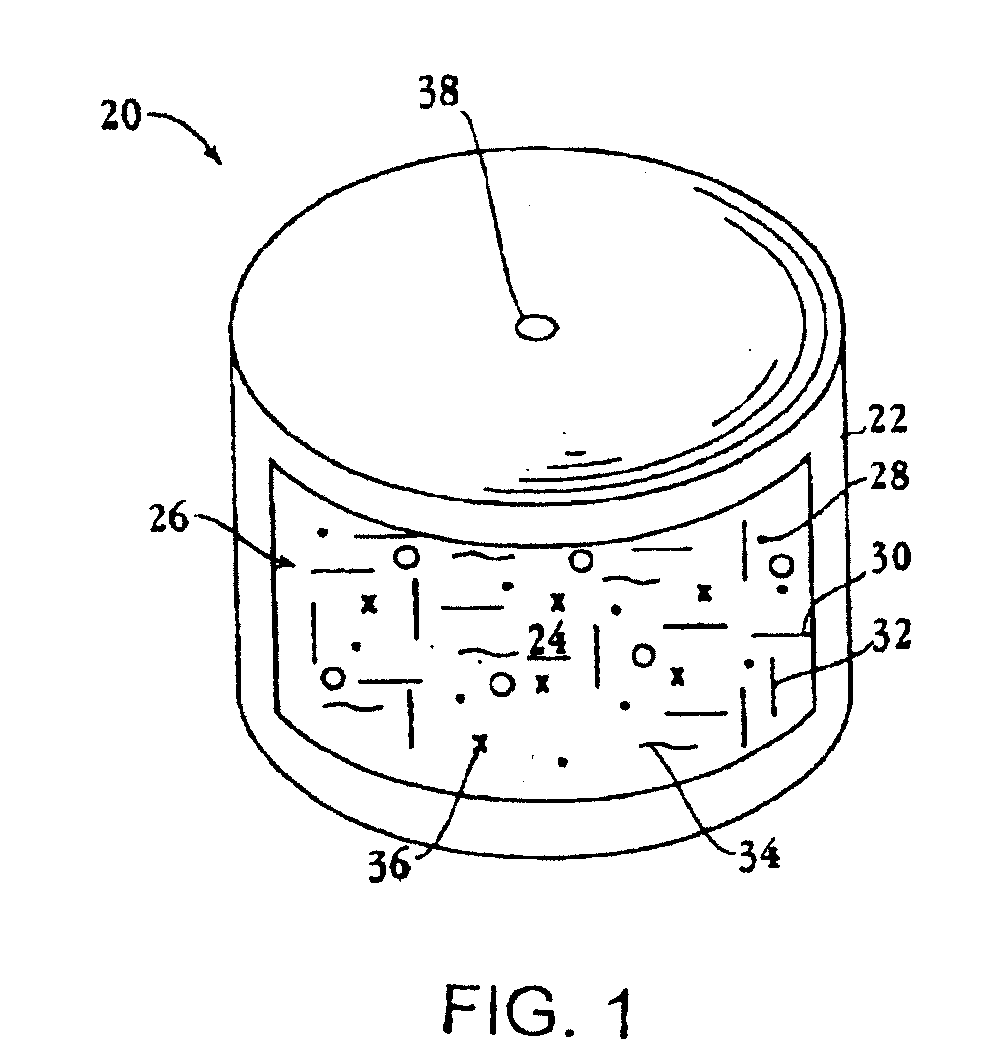Controlled release compositions of tizanidine
a technology of tizanidine and composition, which is applied in the direction of drug compositions, biocide, muscular disorders, etc., can solve the problems of large fluctuations in the release profile, large fluctuations in the blood serum concentration of tizanidine, and tizanidine hydrochloride, and achieve the effect of increasing the concentration of plasma tizanidin
- Summary
- Abstract
- Description
- Claims
- Application Information
AI Technical Summary
Benefits of technology
Problems solved by technology
Method used
Image
Examples
example 1
[0082]Ascending release profiles of tizanidine are achieved using a trilayer configuration wherein two drug layers (Layer 1 and Layer 2) and one push layer were compressed in an osmotic drug delivery (e.g. OROS®) system. Typically drug layer 1 consists of lower concentration of the active ingredient than that in layer 2.
[0083]Layer 1 is manufactured by charging 106.2 g of tizanidine hydrochloride, 1160.3 g of polyethylene oxide (average molecular weight 200K), 75 g of povidone, 150 g of sodium chloride and 0.8 g of ferric oxide into the bowl of a stand mixer. The dry components are pre-blended. Ethyl alcohol is slowly charged into the bowl while mixing. The wet granulation is then sized with a 16-mesh screen, dried at ambient conditions until an acceptable amount of ethyl alcohol remains and then is sized again. Stearic acid is sieved through a 40-mesh, and butylated hydroxytoluene (BHT) is sieved through a 20-mesh screen. Next 7.5 g of stearic acid and 0.3 g of BHT are combined and...
example 2
Results from Ascending Release Profile
[0092]In vitro results: The 22 mg ascending profile systems generated above are subjected to release rate testing using pH 2.0 media. Typical results are shown in FIG. 3.
Example 3
Evaluation of Various Tizanidine Salt Forms for OROS Ascending Profile Systems
[0093]Various salt forms of tizanidine (hydrochloride, hemisuccinate sesquihydrate, sulfate, succinate, hemisulfate hemihydrate) are used to make tri-layer tablets in an osmotic drug delivery (e.g. OROS®) system that releases tizanidine in an ascending profile. The drug concentration is adjusted for the molecular weights of the corresponding tizanidine salts to achieve a dose of 22 mg of tizanidine base. An example for manufacturing the tri-layer tablet with tizanidine hemisuccinate sesquihydrate (Tn HSSH) is given below.
example 3
[0094]Tri-layer systems containing tizanidine hemisuccinate sesquihydrate are made as follows: Ten grams of drug layer 1 is prepared in a beaker scale by charging 8.29 g of Tn HSSH, 76.19 g of polyethylene oxide (average molecular weight 200K), 10 g of sodium chloride, 5 g of povidone and 0.05 g of iron oxide into a beaker and is dry blended. Ethyl alcohol is slowly charged into the beaker while stirring. The wet granulation dried at ambient conditions until an acceptable amount of ethyl alcohol remains. The dried granulation is sieved using a 16-mesh screen and isblended with 0.5 g stearic acid and 0.02 g BHT.
[0095]Next, drug layer 2 is prepared in a similar manner except that the composition consists 27.64 g of tizanidine hemisuccinate sesquihydrate, 66.79 g of polyethylene oxide (average molecular weight 200K), 5 g of povidone, 0.05 g of ferric oxide, 0.5 g of stearic acid and 0.02 g of BHT.
[0096]Next, a push composition is prepared as follows: first, a binder solution is prepare...
PUM
 Login to View More
Login to View More Abstract
Description
Claims
Application Information
 Login to View More
Login to View More - R&D
- Intellectual Property
- Life Sciences
- Materials
- Tech Scout
- Unparalleled Data Quality
- Higher Quality Content
- 60% Fewer Hallucinations
Browse by: Latest US Patents, China's latest patents, Technical Efficacy Thesaurus, Application Domain, Technology Topic, Popular Technical Reports.
© 2025 PatSnap. All rights reserved.Legal|Privacy policy|Modern Slavery Act Transparency Statement|Sitemap|About US| Contact US: help@patsnap.com



